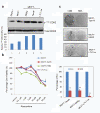Roscovitine confers tumor suppressive effect on therapy-resistant breast tumor cells
- PMID: 21834972
- PMCID: PMC3218960
- DOI: 10.1186/bcr2929
Roscovitine confers tumor suppressive effect on therapy-resistant breast tumor cells
Abstract
Introduction: Current clinical strategies for treating hormonal breast cancer involve the use of anti-estrogens that block estrogen receptor (ER)α functions and aromatase inhibitors that decrease local and systemic estrogen production. Both of these strategies improve outcomes for ERα-positive breast cancer patients, however, development of therapy resistance remains a major clinical problem. Divergent molecular pathways have been described for this resistant phenotype and interestingly, the majority of downstream events in these resistance pathways converge upon the modulation of cell cycle regulatory proteins including aberrant activation of cyclin dependent kinase 2 (CDK2). In this study, we examined whether the CDK inhibitor roscovitine confers a tumor suppressive effect on therapy-resistant breast epithelial cells.
Methods: Using various in vitro and in vivo assays, we tested the effect of roscovitine on three hormonal therapy-resistant model cells: (a) MCF-7-TamR (acquired tamoxifen resistance model); (b) MCF-7-LTLTca (acquired letrozole resistance model); and (c) MCF-7-HER2 that exhibit tamoxifen resistance (ER-growth factor signaling cross talk model).
Results: Hormonal therapy-resistant cells exhibited aberrant activation of the CDK2 pathway. Roscovitine at a dose of 20 μM significantly inhibited the cell proliferation rate and foci formation potential of all three therapy-resistant cells. The drug treatment substantially increased the proportion of cells in G2/M cell cycle phase with decreased CDK2 activity and promoted low cyclin D1 levels. Interestingly, roscovitine also preferentially down regulated the ERα isoform and ER-coregulators including AIB1 and PELP1. Results from xenograft studies further showed that roscovitine can attenuate growth of therapy-resistant tumors in vivo.
Conclusions: Roscovitine can reduce cell proliferation and survival of hormone therapy-resistant breast cancer cells. Our results support the emerging concept that inhibition of CDK2 activity has the potential to abrogate growth of hormonal therapy-resistant cells.
Figures





Similar articles
-
Interference with ER-α enhances the therapeutic efficacy of the selective CDK inhibitor roscovitine towards ER-positive breast cancer cells.J Cell Biochem. 2011 Apr;112(4):1103-17. doi: 10.1002/jcb.23024. J Cell Biochem. 2011. PMID: 21308739
-
Significance of ER-Src axis in hormonal therapy resistance.Breast Cancer Res Treat. 2011 Nov;130(2):377-85. doi: 10.1007/s10549-010-1312-2. Epub 2010 Dec 24. Breast Cancer Res Treat. 2011. PMID: 21184269 Free PMC article.
-
Low-molecular-weight cyclin E can bypass letrozole-induced G1 arrest in human breast cancer cells and tumors.Clin Cancer Res. 2010 Feb 15;16(4):1179-90. doi: 10.1158/1078-0432.CCR-09-1787. Epub 2010 Feb 9. Clin Cancer Res. 2010. PMID: 20145171 Free PMC article.
-
Potential use of pharmacological cyclin-dependent kinase inhibitors as anti-HIV therapeutics.Curr Pharm Des. 2006;12(16):1949-61. doi: 10.2174/138161206777442083. Curr Pharm Des. 2006. PMID: 16787240 Review.
-
PELP1: A novel therapeutic target for hormonal cancers.IUBMB Life. 2010 Mar;62(3):162-9. doi: 10.1002/iub.287. IUBMB Life. 2010. PMID: 20014005 Free PMC article. Review.
Cited by
-
Peptide-Functionalized Nanoparticles-Encapsulated Cyclin-Dependent Kinases Inhibitor Seliciclib in Transferrin Receptor Overexpressed Cancer Cells.Nanomaterials (Basel). 2021 Mar 18;11(3):772. doi: 10.3390/nano11030772. Nanomaterials (Basel). 2021. PMID: 33803751 Free PMC article.
-
Collateral-resistance to estrogen and HER-activated growth is associated with modified AKT, ERα, and cell-cycle signaling in a breast cancer model.Explor Target Antitumor Ther. 2022 Feb 28;3(1):97-116. doi: 10.37349/etat.2022.00074. Explor Target Antitumor Ther. 2022. PMID: 35441158 Free PMC article.
-
Voltage-gated ion channels in cancer cell proliferation.Cancers (Basel). 2015 May 22;7(2):849-75. doi: 10.3390/cancers7020813. Cancers (Basel). 2015. PMID: 26010603 Free PMC article. Review.
-
Acquisition of estrogen independence induces TOB1-related mechanisms supporting breast cancer cell proliferation.Oncogene. 2016 Mar 31;35(13):1643-56. doi: 10.1038/onc.2015.226. Epub 2015 Jul 13. Oncogene. 2016. PMID: 26165839 Free PMC article.
-
PELP1 oncogenic functions involve alternative splicing via PRMT6.Mol Oncol. 2014 Mar;8(2):389-400. doi: 10.1016/j.molonc.2013.12.012. Epub 2013 Dec 30. Mol Oncol. 2014. PMID: 24447537 Free PMC article.
References
-
- Harvey JM, Clark GM, Osborne CK, Allred DC. Estrogen receptor status by immunohistochemistry is superior to the ligand-binding assay for predicting response to adjuvant endocrine therapy in breast cancer. J Clin Oncol. 1999;17:1474–1481. - PubMed
Publication types
MeSH terms
Substances
Grants and funding
LinkOut - more resources
Full Text Sources
Other Literature Sources
Medical
Molecular Biology Databases
Research Materials
Miscellaneous

